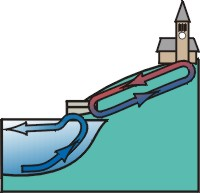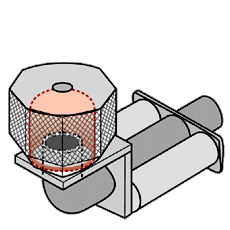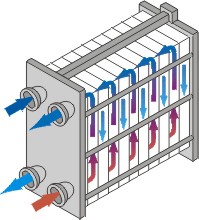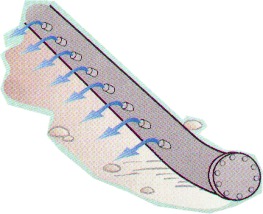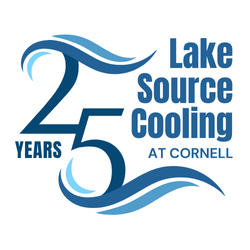How Lake Source Cooling Works
Lake Source Cooling (LSC) System Components:
Loop to Loop
Open lake-water loop: Cold lake water is circulated past the metal surfaces of a heat exchanger in the plant, which cools a district cooling loop used by Cornell and Ithaca High School. This circulated water is then returned to the shallow waters in the lake. The deep waters of Cayuga Lake are a naturally renewable source of chill that save approximately 85% of the energy used for cooling by conventional refrigeration.
Closed campus loop: Energy required to impel chilled water from shore to campus and back is minimized in two ways. Large pipes reduce friction and a closed loop allows warm water coming down the hill to push the cooled water back up to the campus.
Drawing Water
The intake is 10 feet above the lake bottom in water located two miles out and 250 feet deep, where the temperature is about 39°F year round.
Transferring Heat
Since heat flows naturally from hot to cold, a closed loop of chilled water circulating through buildings collects heat removed by air conditioning. Until Lake Source Cooling, Cornell's closed loop was chilled by refrigeration. Lake Source Cooling allows the heat to be transferred to colder lake water - without refrigerants and the energy that produces them. The Cornell water and the lake water never mix.
Returning Water
Water is returned to the lake gradually, dispersed through small holes at the outfall. Clearer than the shallow water it enters, and cooler in all but the coldest months, the returned water has no discernible impact.
Graphics created by Jim Houghton/The Graphic Touch
Lake Source Cooling System Technical Description
The chilled water lines that connect LSC to the campus distribution system are 1005-welded, 42" AP15L Gr X65 steel. The 12,000+ trench feet of supply and return piping was back-filled using controlled density fill and is protected from exterior corrosion using a combination of a three-layer epoxy and polyethylene coating plus a sacrificial anode type cathodic protection system. The transmission piping increased the system volume by 1.7 million gallons of water. Motorized isolation valves are located at the entry/exit point of the chilled water piping within the facility. This allows the plant operator to easily secure the transmission piping in the event of a leak in the plant. Motorized isolation valves have also been installed in a vault where the transmission piping meets the existing distribution network. This allows the operator to secure the transmission piping in the event of a system leak. The chilled water transmission piping passes through a concrete anchor block in the building wall, which is designed to isolate the forces acting on the pipeline outside the facility from equipment inside the facility.
The chilled water system is a "closed" loop. Therefore, the distribution pumps provide no static head to "lift" the water to campus. Only the internal pipe friction due to flow dictates the pumping energy required at the plant. These pumps are used to circulate the closed-loop water from the campus, through the plate and frame heat exchangers and then back to campus. The pump type is a between-the-bearings, radially split, double suction, dual volute designed and built to API Standard 610. There are five chilled water distribution pumps in parallel with a design point of 6,600 gpm at 280 ft. of head. The pump speed is 1800 rpm with 600 installed horsepower each. The pump outputs are controlled via variable frequency drives. The speed is controlled automatically based on system differential pressure on campus. The heat exchangers are piped in a parallel arrangement, allowing any combination of pumps and heat exchangers to be online to meet the system requirements. Each has water piping. This allows the control system to automatically add or remove units from the process as needed. There are seven units installed with a total effective surface area of ~102,000 feet square. The 7th unit was added to compensate for the fouling of all the units and also adds redundancy to the system. Each unit is 100% full of plates (665), which are a "hard angle" chevron design. The design duty is ~36,000,000 BTU/hr (3000 tons) at 4600 gpm and a DT of 16°F per unit. This is done using a LMTD of 2.6°F and a pressure drop of 16psi.
Lake water enters the system via a screened intake structure 10,400 feet away in 250 feet of water. The intake pipeline is 63-inch High Density Polyethylene (HDPE) that was deployed from the surface using a "controlled" sink process where water was pumped in at the shallow end and air was released at the other end. A series of stiffener rings and concrete collars keep the pipeline on the lake floor and protect it from mechanical forces. The outfall is 48 inches HDPE and is approximately 750 feet long. The last 100 feet of the outfall has 38, 6-inch nozzles about 1 foot above the bottom of the lake floor in 14 feet of water, pointed up at a 20-degree angle and pointed north only. This helps promote mixing of the return water into the receiving water.
The intake and outfall pass under a state highway and railroad before entering the facility. 72-inch steel casing pipes were drilled through rock and grouted in place. The 63-inch intake and 48-inch outfall HDPE pipe are installed inside the casing pipes and the annulus is filled with grout. Inside the plant, the casing/HDPE pipe adapts to steel intake and outfall piping. In addition, 63-inch and 48-inch stainless steel slide gate valves isolate the plant from the lake when necessary.
The lake water enters the plant in a 22-foot-wide, 39-foot-long, and 28-foot-deep wet well. A turned-down elbow is installed inside the wet well because the floor is ~15 feet below the pipe invert. The wet well is designed to hydraulically separate the plant piping from the lake intake pipe and protect it from under-pressurization should an inordinate amount of pressure drop develop. This arrangement allows water to flow through the intake to the plant by gravity. At no flow, the water levels in the wet well and at the lake are equal. As water starts to flow through the plant, the wet well level drops below lake level and the resulting difference is the energy that allows the lake water to flow into the wet well by gravity. This level difference is also the exact pressure drop of the intake pipeline. Two-level transmitters monitor this pressure drop and help track fouling of the intake should that occur. The system is also designed to reverse the lake water flow and allow mechanical "pigging" of both pipelines. This would be used to remove an infestation of zebra mussels should it occur. LSC intake piping was successfully cleaned in 2024 using this process.
The lake water pump type is vertical turbine, self-lubricated, enclosed impeller, open line shaft design. These pumps are used to circulate untreated lake water from the wet well, through the plate and frame heat exchangers and back to the lake. The pumps are mounted on a concrete slab which spans the wet well. The pump column is approximately 30 feet long. The impellers sit near the bottom of the wet well and are connected to the driver via a shaft, which extends the length of the pump column. There are three lake water distribution pumps with a design point of 13,000 gpm @ 80 ft of head. The pump speed is 1200 rpm with 350 installed horsepower each. The pump outputs are controlled via variable frequency drives. The speed is controlled automatically based on the number of heat exchangers in operation.
The lake water system is designed as a "siphonic" system. In this type of system, the only pumping power required is to overcome friction even though there is a significant elevation rise to the top of the piping system from the wet well supply. Essentially, as the water "falls" back to the lake in the return piping, it creates a vacuum, which in turn pulls water up into the system through the supply piping. The siphonic principle holds true provided the piping system stays full of liquid, flows fully and remains free of vapor or air. This necessitates the need for an air extraction system, which maintains a full pipe. This system provides the initial system prime and then extracts air gases that come out of solution. Because the lake water is an open body of water, it is essentially saturated with dissolved gases. When this water is subjected to pressures below atmospheric (vacuum), the solubility decreases and gases come out of solution. The increase in lake water temperature as it passes through the heat exchangers creates a similar decrease in solubility, generating additional gas releases. A level switch monitors water level in the pipe system, which opens or closes a control valve connected to a vacuum tank. The vacuum within the tank is maintained using liquid ring vacuum pumps.
Incoming electrical power is obtained via a single 34.5 kv connection from the local utility provider. Power is then split into parallel 2500 kVA transformers at the incoming gang-operated load interrupting switch. Two air-cooled, mineral oil-immersed transformers provide 480 VAC service to the facility in a high-resistance, neutral grounded "wye" configuration. Two separate 480 VAC buses service the facility and are connected to the transformers via a rigid bus. They are installed in a common enclosure with a tie-break switch should a transformer be out of service. The motor control center has a double-ended connection to either primary busways.
The chilled water pumps are driven using a 12-pulse full-wave diode bridge Pulse Width Modulated (PWM), variable speed drive with DC-Link filtering and choke. The inverter section utilizes Insulated Gate Bipolar Transistors (IGBT) to produce a three-phase sine-coded pulse width modulated (PWM) output waveform. Bypass starters are not included. Each has a phase-shifting input transformer that is required for the 12-pulse drive front end. The lake water pumps are driven with the same type of drives except they utilize a 6-pulse front end.
The facility is essentially "unmanned" and the process is totally automated. The process control system is a programmable logic controller (PLC) with redundant hot-backup processors. Direct Modbus+ and Ethernet interfaces are used. The operator interfaces are personal computers (PCs) that use Windows NT as the operating system. These communicate with the PLC, Central Heating Plant (CHP) and existing chilled water plant control systems via Ethernet. The process is monitored by the utilities' system operators on a 24-hour basis from a location approximately three miles from the LSC Facility. These operators are alerted to possible trouble using predetermined alarm limits in the system and can exercise full manual control via the operator interfaces. A dedicated fiber optic link connects the Lake Source Cooling facility with the CHP.
The Lake Source Cooling Control System
The control system utilizes one of five selectable locations on campus for the pump speed process variable. A remote terminal unit (RTU) sends the differential pressure reading (between supply and return piping) to the control system. A master station uses the operator's selected differential pressure location as the process variable and modulates the pump speeds to maintain the process variable at the set point. If the differential increases, the chilled water pump speed will decrease and if the differential decreases, the pump speed will increase. The chilled water pumps are sequenced on and off automatically by the control system depending on the total system chilled water flow.
The heat exchangers are also sequenced on and off automatically by the control system depending on the total system chilled water flow. Any time a heat exchanger comes online, the lake water pumps automatically ramp up to meet an operator's selectable lake water flow-rate per heat exchanger. This is done to maintain a minimum velocity of lake water through the heat exchanger plates, which in turn minimizes the propensity to foul. The control system determines the set point for total lake water flow by multiplying the number of heat exchangers online times the target flow per heat exchanger as input by the operator. Should the leaving chilled water temperature exceed an operator-determined set-point, the lake water system will automatically switch to temperature control mode and ramp the pump speed up to maintain the leaving chilled water temperature. Should the leaving chilled water temperature go below the set-point, the lake water system will automatically switch back to flow control mode and maintain the minimum desired flow-rate per heat exchanger.
A fully automated pump booster station was also employed to alleviate high differential pressures in the core campus distribution system. A 24-inch "spur" feeds a section of the campus that is on the fringe of the networked distribution piping. By adding a pump in series at the interconnection of this spur, the pumping energy needed at the LSC facility was greatly reduced, as was the capital cost associated with it. This pump booster station is installed in an underground vault and includes a variable speed drive and RTU.


